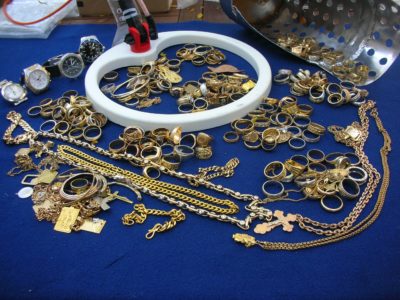 When you go to the lower uSc ranges–its necessary to do certain thingss to mediate the micro conductors. This may involve coil control (determining the solidiy) using the cross sweep and multiple passes, or doing some “foot digging” to make sure the target is not a small target on the surface. It’s also important to look for ground that itsn’t “silt” carrying this type of micro conductors around–oval tabs, foils, pennies and caps. This is the “tradeoff” for the additional depth you get running down at say 10 uSc. Where you have a lot of targets, there is more of an emphasis on checking the general features ofa response–size, shape and where it is sitting in the strata. To a certain extent, understanding the sand texture is one thing that helps you recognise what an object is–by how deep it’s sitting. People ask why I have a large number of pulse machines. This is because they all do different things and are suited to different condtions. My small coil Cuda is great in black sand of harsh, fast salt conditions. It also has great audio to keep off the caps and pins. The Dual Field also has great audio and gives a long “tune-out” sound on iron. The Aquasearch has great optimization and adjustable SAT–for sidewalls or fast water.–to compensate for interference. More generally the idea with a pulse is to incorporate site knowledge and a number of target features into your dig selection. While iron will sound off–it doesent “carry” to the surface as well. Looking for small, sharp, narrow responses that don’t give a double tone on the cross sweep can reduce the amound of iron you dig. As well, when you turn the Gain (or de-tune) a pulse, the response to iron is reduced more than is the response to gold. So in dense traash going to a lowered “discriminate” mode, combined with carefull listening to the strength of your signals is another way to increase your accuracy. I’ve made all my best finds with pulse machines and although its great to have the fidelity and accuracy of a CTX or EQ, where there is any serious competition or changing “sanded in” type conditions a pulse is the way to get down deeper, find “strip outs” and hit those big lunkers. Pulse hunting teaches you to examine responses fully, and pay attention to the strata, grade, bottom contours and sand textures. These skills in turn will help you with any machine you use. cjc
When you go to the lower uSc ranges–its necessary to do certain thingss to mediate the micro conductors. This may involve coil control (determining the solidiy) using the cross sweep and multiple passes, or doing some “foot digging” to make sure the target is not a small target on the surface. It’s also important to look for ground that itsn’t “silt” carrying this type of micro conductors around–oval tabs, foils, pennies and caps. This is the “tradeoff” for the additional depth you get running down at say 10 uSc. Where you have a lot of targets, there is more of an emphasis on checking the general features ofa response–size, shape and where it is sitting in the strata. To a certain extent, understanding the sand texture is one thing that helps you recognise what an object is–by how deep it’s sitting. People ask why I have a large number of pulse machines. This is because they all do different things and are suited to different condtions. My small coil Cuda is great in black sand of harsh, fast salt conditions. It also has great audio to keep off the caps and pins. The Dual Field also has great audio and gives a long “tune-out” sound on iron. The Aquasearch has great optimization and adjustable SAT–for sidewalls or fast water.–to compensate for interference. More generally the idea with a pulse is to incorporate site knowledge and a number of target features into your dig selection. While iron will sound off–it doesent “carry” to the surface as well. Looking for small, sharp, narrow responses that don’t give a double tone on the cross sweep can reduce the amound of iron you dig. As well, when you turn the Gain (or de-tune) a pulse, the response to iron is reduced more than is the response to gold. So in dense traash going to a lowered “discriminate” mode, combined with carefull listening to the strength of your signals is another way to increase your accuracy. I’ve made all my best finds with pulse machines and although its great to have the fidelity and accuracy of a CTX or EQ, where there is any serious competition or changing “sanded in” type conditions a pulse is the way to get down deeper, find “strip outs” and hit those big lunkers. Pulse hunting teaches you to examine responses fully, and pay attention to the strata, grade, bottom contours and sand textures. These skills in turn will help you with any machine you use. cjc
clivesgoldpage.com